The Arctic is being militarized by Russia and has created tensions in the Arctic. My presentation focuses on “What is the Likelihood of conflict in the Arctic between NATO and Russia?” I focus on 4 main factors that include Russia’s and NATO’s approach to the Arctic, potential for conflict, potential for Cooperation, and Recommendations for the region. NATO has two main approaches that include the old approach to the Arctic and new approach to the Arctic. The old approach is that NATO has been in opposition to Russia and traditionally taken an observational role in the Arctic with the Arctic Council taking the initiative on policies such as climate change. The new NATO approach is concerned about Russia Rhetoric in the Arctic and helping Norway take an aggressive policy in protecting their economic interests through military exercises. Russia also contained an old and new approach that focused on Arctic Security. For example, Russia’s old approach included an active presence in the Arctic region during the Joseph Stalin era and invested capital in railroads, sea transports, and Arctic pilots. Similarly, Russia’s new approach is on taking an aggressive military policy and investing into infrastructure such as basses, airfields, roads, and more. You will find below Russian military build up and the infantry base, headquarters, naval bases and more.

The potential of conflict is high due to Russia’s increased military build up in the Arctic. For example, Russia is renewing the use of bases positioned in the Arctic region since the Cold War, Creating a long term compared to short term military strategy, developmenting of the Poseidon 2M39 torpedo, and Increasing investment into aircraft, naval fleets and intercontinental ballistic missiles. Furthermore, Russia is taking advantage of climate change by opening up shipping lanes in the Arctic, extracting vital minerals such as nickel, iron ore, and phosphates, extensive oil and natural gas extraction, and having new fisheries in the Arctic. Similarly, NATO is also increasing the potential for conflict by increasing military drills and investment in the Arctic and Norway Convincing NATO to get involved through military exercises like “Trident Juncture.” Furthermore, Canada and Denmark are deploying military personnel in the Arctic and strengthening their Arctic sea capabilities. Below is Dutch soldiers march during a NATO military exercise in Lithuania in 2018.

In contrast, there is likelihood of cooperation between NATO and Russia such as Russia’s new domestic policies such as “Russian State policy in the Arctic 2008” wanting cooperation and peace between Arctic states and there are Incentives for Russia to continue being cooperative due to them working in a rigorous environment, Arctic issues, and economic development. NATO also wants cooperation in the Arctic by communicating with Russia and compromising and their priorities to make Russia not feel the need to militarize. Below are recommendations that I would create to help reduce the tensions in the Arctic.
Recommendation 1:
For a more peaceful approach to the Arctic, Russia should decrease their militarization of the Arctic:
-
Reducing Russia’s militarization of the Arctic can be beneficial for all Arctic States
-
Reduces tensions in the region between Russia and NATO countries
-
Decreasing military activities in the Arctic
-
-
Cooperating and communicating with the Arctic Council
-
Russia making compromises on policies and communicating their concerns in the Arctic
-
-
Making Diplomatic accommodations to countries concerns
-
Russia could accommodate countries by compromising on territorial disputes
-
Recognizing that countries are scared of Russian build up and should assure countries that Russia won’t attack
-
-
Becoming more Transparent about their Arctic policies
-
Showing exactly what they are doing in the Arctic and why they need to militarize the region
-
-
Russia Following Arctic Guidelines
-
Reducing their pollution in the Arctic and giving indgnioues groups more rights
-
-
Recommendation 2:
NATO should increase their military in the Arctic to reduce tensions between NATO countries and Russia:
-
Balancing the military drills and operations between NATO and Russia
-
Allies such as Canada, US, Denmark, and Norway need to resolve their borders in order to focus on Russian Militarization
-
-
Make every reasonable effort to include Russia as an Arctic partner to reduce misunderstanding
-
Pressure Russia into cooperating with the Arctic Council to solve disputes
-
Maintaining a safe distance from Russia’s unpredictable behavior by avoiding accidental escalation
-
-
Monitoring the region and encouraging improvements in awareness and access to the Arctic region
-
Investing into infrastructure that would persuade Russia not to attack
-
Investments by NATO in the Arctic would reduce tensions between Norway and Russia
-
-
NATO becoming a deterrence to Russia to discourage Russia from harassing their military and commercial aircraft and ships around the Arctic
[ensemblevideo version=”5.6.0″ content_type=”video” id=”65b18b71-4ec9-47de-b01e-93ab933488a0″ width=”848″ height=”480″ displaytitle=”true” autoplay=”false” showcaptions=”false” hidecontrols=”true” displaysharing=”false” displaycaptionsearch=”true” displayattachments=”true” audiopreviewimage=”true” isaudio=”false” displaylinks=”true” displaymetadata=”false” displaydateproduced=”true” displayembedcode=”false” displaydownloadicon=”false” displayviewersreport=”false” embedasthumbnail=”false” displayaxdxs=”false” embedtype=”responsive” forceembedtype=”false” name=”Arctic Conflict”]